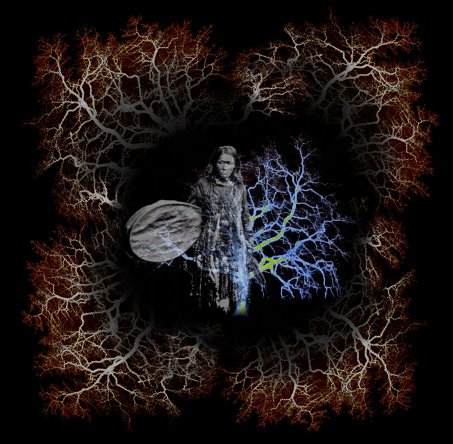
Shamanic Teachings of the Families of The Americas
The Story of the Solutrean Confederation
Page 15
This page addresses a few large
subjects that for now will only be an introduction. The historical
information in this section has not been authenticated by the academic
world. Other than the diagrams of the lithics styles, locations, and
references all the information below comes from what I have been taught,
by the ancient ones.
Current understandings of the Solutreans (of France and
Iberia) are that they appeared from nowhere and then disappeared into
history leaving art and artifacts of exceptionally advanced styles for
the period. In 1998 the concept of the Solutreans migrating to North
America was first
proposed by Dennis
Stanford, of the Smithsonian Institution, and Bruce Bradley, of the
University of Exeter. According to my teachers this migration is
accurate concept, but it needs rewriting. This page is an introduction and a
small segment of what I was taught on the related subjects below:
The Solutreans were a “culture” made up
of 12 different groups of people. It was through the exchange of ideas
and technologies of these 12 amalgamated peoples that a new alliance was
created. They had varying abilities in human evolution and spiritual
awareness but together they created the most important and culturally
innovative movements in history. I’m told that the Solutreans were a
confederation more than a true culture and were the creation of shamanic
councils that were working and sharing the same sacred caves shown in
the last page (pg.14b). The Solutreans were so historically important
that in my first inquires about them I had trouble accessing any
information at all. I was told this was due to the fact that it had to
be accurate and historically all encompassing, otherwise nothing would
be divulged. This is the reason why so many varied subjects are
addressed in this brief story of the Solutreans.
After a three year period of shamanic work, I now have a good chronology of the events that led up to the peopling of the Americas and a migration that seeded future cultures on both sides of the globe. It must be understood that the Solutreans were not the first people to the Americas. The Americas were populated by two different surviving groups prior to the Solutrean migrations; these people are referred to (by my sources) as the “Originals” (in this case, of the Americas). Originally there were three families in the Americas but the northern family did not survive. A group from the middle original family lived in the Valsequillo Reservoir area of Mexico and a southern family can be found in South America (as demonstrated in the Sumidouro and Lagoa Santa Sites of Brazil). To put this in a historical context these people can be equated to the European Acheulean level, and of the same time period! Like the American Originals my sources also call these European ones Originals, but to that area.
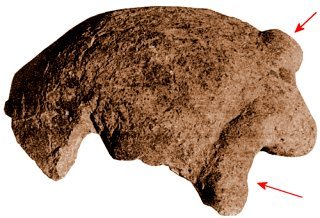
A skullcap from Lagoa Santa, Brazil. Notice the heavy
brow ridges and thickness of the skull that are typically associated
with a Homo rectus type or a transitional form of Homo sapiens.
The Originals

The land bridge opened and closed throughout history. The North Original
family (in blue) was pushed out by glaciations. Some members crossed
into Siberia prior this and a few made it south down the East Coast of
America.
Very briefly; all animals are created in three versions
of their species, humans are no exception. Two variants will be
energetically opposite of each other, to create a genetic and energetic
balance in a reality. The third variant acts as a catalyst to create
movement within this balanced duet. By creating imbalance within the
other two variants it allows evolution or growth can take place. This is
the only way to maintain existence in the physical reality, for any
length of time (no growth – no purpose – no longevity). These third
variants are always from a higher or lower vibrational level than the
other two physical “seed variants”. In fact, the third variant injection
into the reality may or may not be a physical form. To understand human
evolution you must see the three variants or “families” in any given
time period or region. That also includes today’s people. This
understanding is not withholding that one or two variant parts can
become extinct leaving the lasts variant in the physical for a
predetermined period of time. This determined time period is dependent
on many things including soul level requirements and the environment’s
vibrational level that can support these requirements.
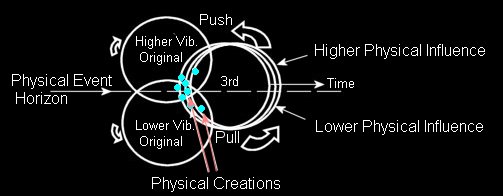
Creation starts in the nonphysical, above and below the
physical event horizon of a reality (Upper and Lower Worlds in shamanic
terms). This can be seen in physical DNA as two helixes. The third
influence (third DNA strand) is in a layer above or below. The primary
helix structure is always there but it is not seen in the physical.
Also, the influential third can still be created in a physical form, but
again its own “mirrored influence”
(in
another layer) will not be seen in that ones DNA
spheres or helixes. (This material is rendered down to the most basic
explanation I can manage, for is a very complicated subject).
Briefly again, my teachings started with what is
referred to as the “European Originals”. Historically we call them the
Acheuleans, although academics only see one or possible two types, there
were in fact many. Around 100,000 years ago the first true humans were
created. Academics also want to see older versions of bipeds as humans
too, but they were not. As addressed in the last page, humans are an
ensoulment of two different soul aspects. A true human conscious form is
more than the physical biological apparatus, which consists of its own
consciousness.
As with humans, all animals are created in threes, with
the third variant influencing the other more physical reality forms. The
rate of injection of this third sphere dictates the species speed of
evolution. In modern humans this speed is thousands of times quicker due
to higher vibrational injection. In the beginning of true humanity,
regional bipeds (human body forms) were used as seedlings for this third
spiritual injection (our consciousness). This could be a lower or higher
vibration depending on the region’s environmental vibration. The Earths
vibration is always cyclically shifting, so some species will not fit
into the new vibrations. Yes, evolution of species and the extinction of
some are not a negative thing for life forms, as their individual
vibrational rates must comply with their environment’s vibration. Human
DNA shows itself in the physical, with two helixes matching the
environment’s vibration and a third as an injected nonphysical
influence. These nonphysical helixes continue up in 12 levels and are
always nonphysical, in this present Earth reality.
Note: Spiritual awareness is the
ability to connect to these other levels and maintain it in the physical
reality.
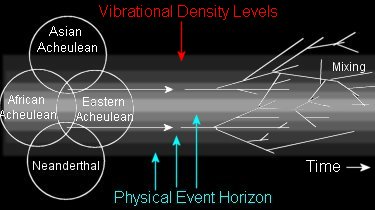
The placement and order in the above diagram is a
visual representation only.
Encompassing most of the planet, the Acheulean
proto-cultures of 100,000 years ago consisted of 18 different types of
true humans. The pattern of three variants were created in 6 different
regions or land masses (no, Africa is not the birth place of humanity, as
there were several places). Not all of these Acheulean types survived
due to regional vibrational and climatic variants, but the initial
creation of three had to be there to kick start the physical survivors,
be it one, two, or all three types. They created localized
proto-cultures that survived for thousands of years. These
proto-cultures eventually met their neighbours and mixing occurred. The
blending of different human species created the groups of the Upper
Palaeolithic (Gravittian and others like the Douxcan – Pre Solutreans).
Parts of Darwin’s theory are correct just like parts of the
creationist’s understandings are correct, but there is much more
involved. Basically, species can “ignite” into existence, and yes they
do evolve from there. I understand that this statement might appear to
be illogical to many but if your only focus on life is the physical;
then 90% of the information is missing.
The bottom line is that all specie’s templates can be
found in our DNA, which gives an insight into what purpose “junk DNA”
has. It is consciousness (an aspect not found in the physical mind) that
dials in the desired form through all the possible DNA blueprints. This
will always be an ongoing issue for mapping genealogy or race, as you
cannot back track consciousness through a chemical analysis. The diagram
I was shown consisted of thousands of parallel strands of physical
reality possibilities (coordinated with DNA variety), and through these
strands was a weaving consciousness. So following a DNA strand back in
time can show a probable past time form, but not necessarily in the
family line you are interested in or following.
To make things even more complicated, time frames are
not consistent. They vary throughout the universe, and the Earth’s own
past. Every Earth Shell Level had a different time frame, in comparison
to today perception (our Reality Shell). After all, what separates
events is not time but the perception of time. We perceive events in a
lineal fashion, or “one event at a time”. Lifetimes, even within
reincarnation profiles, are not in a lineal time frame. (For the alien
buffs out there, this is the reason why Zeta Reticuli need to tag
individuals when following the family line.)
The academic world sees humans in a much older context.
They see humans coming from a long line of biological evolutionary links
going back into the range of a million years. These individuals were not
true humans as they were not of human consciousness. Bones and tools
will never show the levels that make up the conscious composite we call
human. The others were life expressions of biological form without human
ensoulment. Species wise, there is no difference between fifty types of
apes in the Miocene any more than many prototypes of humans, after all
nature tries on many garments before selecting survivors. Also, the
production of simple tools is not proof of ensoulment.
During the upper Palaeolithic period different groups
of people populated the French-Iberian Peninsula. Their style of life
had been untouched for thousands of years, that is until the environment
changed in other areas. It was this change that led to the migration of
an eastern group of people that changed everything for them. These
eastern people were of a different creed and vibration. Their awareness
level showed in their creativity, this is a powerful aptitude that
allows one to accept change. As their environment changed and resources
pushed them into wider fields of travel they soon realized that it was
time to search for a new land of plenty. Because they had spread so wide
in their original domain it was natural that some would migrate east and
others would go west. These people of the Caucasus where hemmed in
between two seas and a mountain range. Although some did travel south
the largest movement became a migration over the top of the seas in
opposite directions. Their path into Western Europe crossed local
sedimentary peoples allowing for an exchange of ideas and technologies.
This was also repeated in the eastern migration through Asia and
Siberia. The evidence of this will not be found, as it is subtle,
showing only as enhanced technologies that they already had. For the
eastern migration, this unique journey allowed for an exchange of some
ideas but it was not until they settled down in the Iberian Peninsula
that things really changed. In the French-Iberian area many other groups
were also crossing paths with the locals, and now it was with the
Pre Solutrean-Douxcan. This created a “united nations” of the day.
These eastern Proto Solutrean
(Douxcan) people are the “third group injection” for this region of
human development. Being of a higher vibration made them a catalyst for
creating the Solutrean Confederation. I was told that this eastern group
of people called themselves the Douxcan. The name is a base name as
prefixes were added to signify areas or abilities of different parts of
this family group. Their origin was the Caucuses and they entered the
area in two separate waves separated by a few hundred years, around
22,300 years ago. At the same time the other half of the Douxcan
migrated further east and eventually into the Americas (around 22,000
BP). I call this group the Solutrean 1s, even if they did not have the
same France-Iberian expression; they are the same root family and
creative process. Similarly, the eastern migration also mixed and
exchanged with people along their migration into the Americas. This
mixing can be seen in the Dyuktai artifacts from Siberia, also found in
Washington (see picture below from my collection).
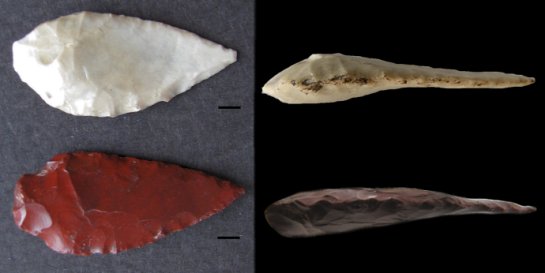
Dyuktai points: Bottom point - from Washington, Olympic Peninsula – top
point is from Siberia. They called themselves the Sarkeelar people. They
are a direct descendant of the Asian Acheulean. The Jasper Washington
point shown was created by the last of these people in the Americas
(8,750 BP). This projectile point can also be seen in the first
Solutrean diagram below - bottom right corner, as they were the most
eastern influence of the Douxcan.
Below are a few notes on the peopling of the Americas.
Along with these are self guided maps. In the last diagram on this page
I have placed a family tree of some currently recognized groups in North
America. This diagram shows who is related to whom, as outlined to me by
the ancient ones from the periods. It is not complete by any means but
rather it supplies a chronology of how complex history can be. I was
informed not to bother going any newer than 5,000 years ago as the Soul
Group mixing is too complicated and not worth the effort.
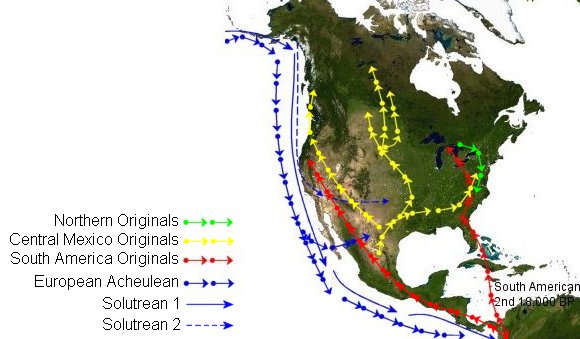
Below are two diagrams of the French Solutrean lithic
styles. You do not need to be an expert to see that there were many
different lithic typologies. It is an indicator of different people that
lived in the area under the Solutrean banner and time period. This
diagram is a collection of Solutrean projectile points from the French
book “Le
Solutréen en France”
which can be found on the internet, compliments of the visionary Bruce
Bradley of the University of Exeter.
Publications de l’Institut
de Préhistoire de l’Université de Bordeaux, No. 5.
Author: Philip E. L. Smith
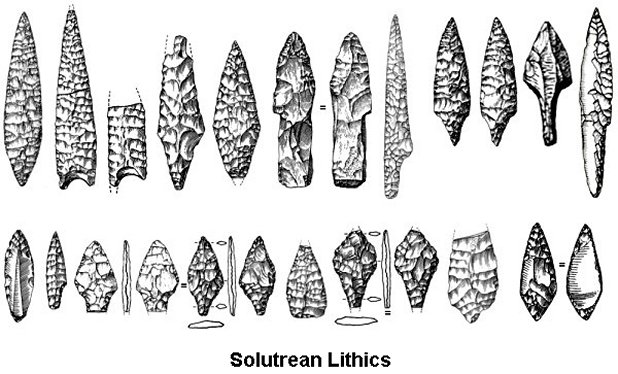
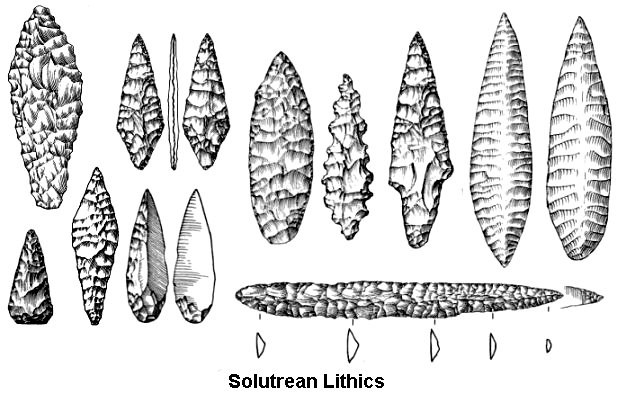
It is interesting to see the different styles, as all
these styles can be found in western North and South American
typologies. I especially like the top left one in the second diagram.
This is known as a Lake Mojave point and can be found in the American
west. It is commonly associated with the “Great Basin Stemmed Cluster”,
a Paleoindian period of 11,000 BP. This is the oldest assigned date for
this projectile in known sites of this region. What is not known or
recognized is that this culture and other Solutreans types can be found
many miles to the west, now under water. Below are some diagrams of the
“Homeland” (as the ancient ones from the time period tell me).
Note: Shamans inspired the family clans to create the
confederacy. I was told that shamans have ability to change the
direction of a lineage or family path to be taken. They can influence
all levels, thus creation is possible, as they are also co-creating with
the groups desires for change.
Note: Shape of points indicates the family origins
(spiritual Soul Group injections) regardless of the location or time
frame. A shift in a style is usually an indication of a new Soul Group
connection or combination (spiritual expressing in physical). This
applies to all lithic styles from North America to Africa. Soul level
families are not restricted to terrain or time.

As you can see, it was a big trip eastward for them,
that is, if they were to wander onto our dry land and have their sites
discovered. In other words there had to be good reason for venturing
this far east, to create a site for modern archaeologists to discover.
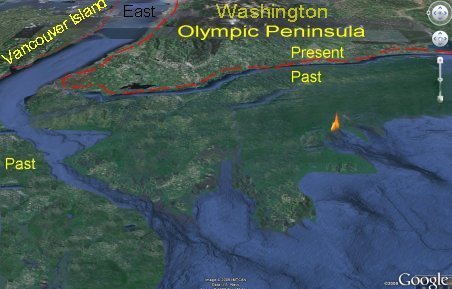
You had to pack more than your lunchbox to get onto our
present land! This would also be in the process of passing all that you
needed in the way of resources.
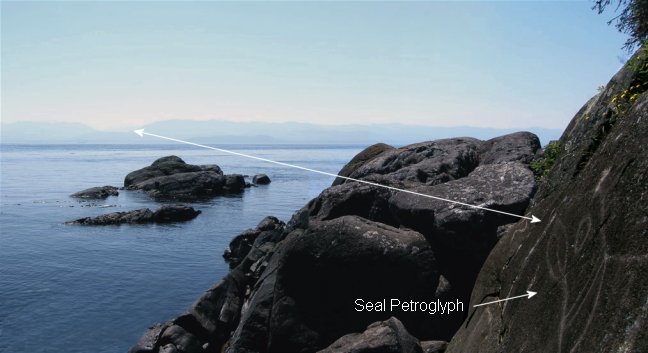
A seal petroglyph marks the direction to the Homeland.
This ancient petroglyph site shows the direction, through a “visual”
pass in the mountains, to an off shore original settlement. The seal is
a shamanic symbol for having the ability to live in two realities, air
and water, which is fitting considering the location of this submerged
homeland. The shamans working at this East Sooke site utilized the
unique energy of the spot (a horizontal vortex flow, just behind this
rock outcrop). This vortex spot is very conducive to physical or “Middle
World” work. The site can be accessed from the Aylard Farm entrance of
East Sooke Park, B.C. From there it is a right turn at the ocean and
around the point. See the Olympic Mountains (and the opening in the
mountains) in the background of the photo.
See Google Map at bottom of page for location

The seal petroglyph at East Sooke Park, B.C. points to the Homeland off Washington coast.

East Sooke Horizontal Vortex – pictograph is jut to the left of picture. Valley towards the Homeland, just right of the tree. The Olympic Mountains in the background.

Solutrean 2 made two separate migrations a few hundred years apart.
First group of Solutrean 2s split into two forks in Texas, after mixing
with ones from Mexican Originals of this area. Diagram does not show
later migrations, as there were many, in both directions.
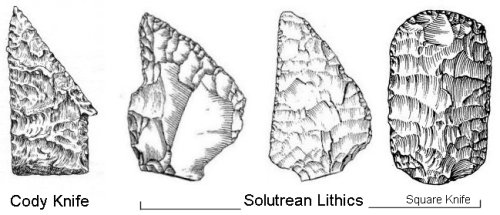
Above
the comparison of Cody Complex and Solutrean knives. The Solutreans even
had the famous Square Knife in their tool kit.
The best places to look for the original Solutrean camp
sites are now under water. Unfortunately these ideal sites will be at
best transitional sites as they had already mixed with groups along the
way. Remember, this was not a culture per se, it was a confederation and
thus contact with new peoples along the way would have had mixed results
on different members of this Solutrean #2 group. The first “Solutrean”
group would have been more traditional due to their longer establishment
as the Douxcan.
The second best area on today’s dry land will be areas
of lithic stone source. One such area also turns out to be a large
vortex area that the ancient shamans recognized. This spot is a
complimentary “opposite directional flow” of Mtn. Shasta and can be found
in the Paulina Lake area of Oregon. In this Deschutes River Basin there
are many Cache Blade stashes as the power was well recognized and
utilized for shamanic work. The largest of these cache blade sites is
the Paulina Lake or Dietz Cache site, which contained over 2130 pieces.
All the points of the cache were Obsidian and Dacite except for one
which was a butterscotch coloured jasper. Most of these blades are
unifacial, have extended needle tips, and many have fractured bases.
Most of them have extremely heavy patination showing their antiquity.
Having three points from this cache, I asked about the
broken bases and was told that some were the original blade style, Solutrean
#1 (Douxcan) and a shaman, thousands of years ago, decided to modify
them to match a more current style of the time, the Cascade point
(Solutrean #2). No explanation was offered to why this shaman thought
this was important other than the possibility of cultural friction with
the older first group.
If an obsidian point is handled or carried allot with
other points it will show the effects as having a striated surface, as
seen in right side photo. In other words some of these blades were
carried great distances, together as a collected cache, rather than a
piece for a locale hiding spot. Many researchers see the cache blade
collections as practical labour saving method of storing. This can be
the purpose for some but not all of them. The point shown here proves
that it was transported with others and kept in a bundle for a long
time. These types of caches are of past shamanic family energies. There
is no difference between this cache method and that of painted hand
prints on a cave wall. From this Paulina Lake Cache the shamans had
access to their ancestor’s energies and their knowledge (from a shamanic
side). As an example I was told that with my first blade (shown below) I
had access to 500 shamans out of the 2130 blades that were part of this
cache. This cache took thousands of years to collect and I would like to
offer one or two of mine to the practising shamans reading this
material. I will post one in the upcoming weeks or you can write me. My
ideal wish is to keep these blades away from the collectors, as there is
much to learn from them.
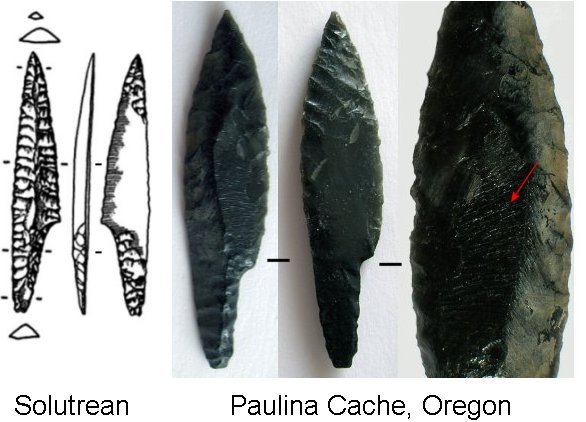
The point shown above is from my collection and judging
by the remaining knapped material; I restored it to its original shape.
Along with this one I have place another Dietz Cache blade (below) from
my collection to show the area of breakage. Notice it is the same
unifacial lithic style of knapping as the older Solutrean #1 family
used. The style can also be seen in the second Solutrean Lithic diagram
above.
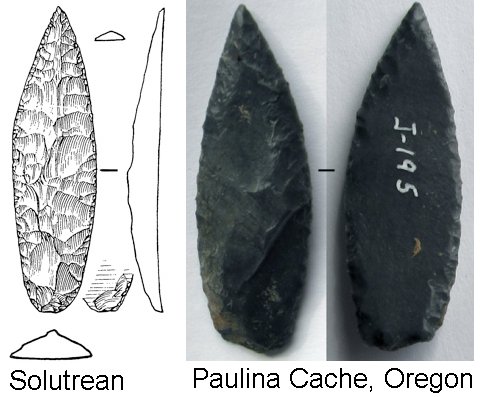
My teachers were quick
to point out that there are many misconceptions in the current
understandings of ancient people. One of these is the need to separate
people into different cultures and races. My teachers used the word
Era to describe the
differences. An era in any
culture is sometimes called a new culture in some academic circles.
In other words many so called different cultures (based on excavated
material) are nothing more than eras or variants of the same culture due
to influx of new ideas or environmental changes. If you look at objects
and fashions from the 1920s era you can see there is a huge difference
in styles from today. Archeologically, are we a different culture from
our fathers or grandfathers time? Some would say yes, but they are
assigning a different soul lineage to a family evolution. There is no
way to determine accurately from one era to another with utilitarian
objects. If you can observe spiritual icons, and the focus around these
objects, a clearer picture could be perceived. Also, in this same
subject, I have been shown that other than some functionality, the
general shape of a projectile point is directly contributed to how a
culture sees itself. This is directly proportional to their Soul Group
Level and icons from this nonphysical level.
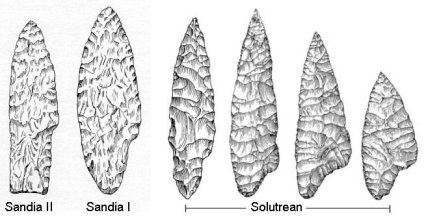
Note: Sandia – one shouldered ones of the Solutrean #1
and a mix with Originals of Mexico - co created or mixed with second
wave of Solutreans #2 as part of the Clovis creation. The Clovis are
thus a spilt family of the older groups and an end of these original
families.
Note:
Redstone part of Original family from Mexico – retreated after
Solutreans mixes showed up.
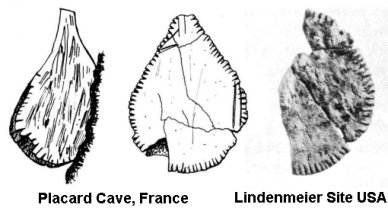
Rare objects from two continents – made of bone.
South America holds the answers to North America’s
Paleo past.
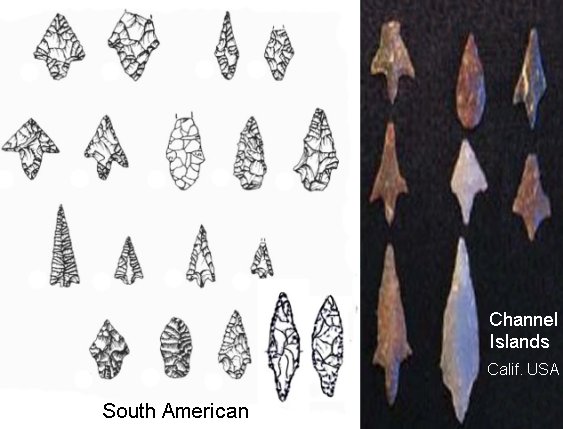
Public release date: 3-Mar-2011
541-346-3481
University of Oregon
California islands give up evidence of early seafaring
Evidence for a diversified sea-based economy among North American
inhabitants dating from 12,200 to 11,400 years ago is emerging from
three sites on California's Channel Islands.
Reporting in the March 4 issue of Science, a 15-member team led
by University of Oregon and Smithsonian Institution scholars describes
the discovery of scores of stemmed projectile points and crescents
dating to that time period. The artifacts are associated with the
remains of shellfish, seals, geese, cormorants and fish. "This is among
the earliest evidence of seafaring and maritime adaptations in the
Americas, and another extension of the diversity of Paleoindian
economies," Erlandson said.
Last year, Charlotte Beck and Tom Jones, archaeologists at New York's
Hamilton College who study sites in the Great Basin, argued that stemmed
and Clovis point technologies were separate, with the stemmed points
originating from Pacific Coast populations and not, as conventional
wisdom holds, from the Clovis people who moved westward from the Great
Plains. Erlandson and colleagues noted that the Channel Island points
are also broadly similar to stemmed points found early sites around the
Pacific Rim, from Japan to South America.
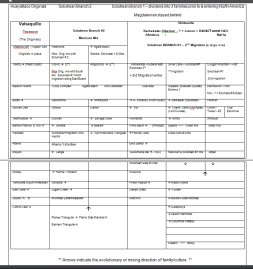
This above chart shows who is related to whom,
as outlined to me by the ancient ones from the periods. It is not
complete by any means but rather it supplies a chronology of how complex
history can be. I was informed not to bother going any newer than 5,000
years ago as the Soul Group mixing is too complicated and not worth the
effort.
Note: For researchers – the Solutreans and their path in Europe and North America can be traced via sweetgrass species. Apparently they developed a close spiritual association with the Eurasia sweetgrass (Anthoxanthum odoratum) carrying it with them on their travels.
A final note: I did not fabricate the information on this site. But if there are those that find the information contrary to their beliefs, I fully recommend that they take it up with the ancient ones. Maybe they were wrong!
DNA evidence uncovers major upheaval in Europe near end of last Ice Age
The lasted scientific discoveries about prehistoric origins - pdf
New Solutrean Discoveries New
Also See: Solutrean Boats
Cave de Vinci
Page 17

Home
Site Map
For further reading page 16: Consciousness Has
Structure
View Larger Map
Home New Pages added
Interesting News
PUBLIC RELEASE DATE:
20-Nov-2013
Ancient Siberian genome reveals genetic origins of Native-Americans
The genome sequence of a 24,000-year-old Siberian individual has provided a key piece of the puzzle in the quest for Native American origins. The ancient Siberian demonstrates genomic signatures that are basal to present-day western Eurasians and close to modern Native Americans. This surprising finding has great consequences for our understanding of how and from where ancestral Native Americans descended, and also of the genetic landscape of Eurasia 24,000 years ago. The breakthrough is reported in this week's Nature (Advance Online Publication) by an international team of scientists, led by the Centre for GeoGenetics at the Natural History Museum of Denmark (University of Copenhagen).
The search for Native American ancestors has been focused in northeastern Eurasia. In late 2009, researchers sampled at the Hermitage Museum, St. Petersburg the remains of a juvenile individual (MA-1) from the Upper Palaeolithic site of Mal'ta in south-central Siberia. The MA-1 individual dated to approximately 24,000 years ago. Now, the team reports genomic results from the MA-1 individual which unravel the origins of the First Americans – ancestors of modern-day Native Americans.
"Representing the oldest anatomically modern human genome reported thus far, the MA-1 individual has provided us with a unique window into the genetic landscape of Siberia some 24,000 years ago", says Dr. Maanasa Raghavan from the Centre for GeoGenetics and one of the lead authors of the study. "Interestingly, the MA-1 individual shows little to no genetic affinity to modern populations from the region from where he originated - south Siberia."
Instead, both the mitochondrial and nuclear genomes of MA-1 indicate that he was related to modern-day western Eurasians. This result paints a picture of Eurasia 24,000 years ago which is quite different from the present-day context. The genome of MA-1 indicates that prehistoric populations related to modern western Eurasians occupied a wider geographical range into northeast Eurasia than they do today.
Dual ancestry of Native Americans
The most significant finding that the MA-1 genome reveals is its relation to modern Native Americans. This relative of present-day western Eurasians shows close affinity to modern Native Americans, but surprisingly not to East Asians who are regarded as being genetically closely related to Native Americans.
Furthermore, the team finds evidence that this genetic affinity between MA-1 and Native Americans is mediated by a gene flow event from MA-1 into the First Americans, which can explain between 14-38% of the ancestry of modern Native Americans, with the remainder of the ancestry being derived from East Asians. Supported by numerous reasons against these signatures being caused by contamination from modern DNA sources or from post-Columbian admixture (post 1492 AD), the study concludes that two distinct Old World populations led to the formation of the First American gene pool: one related to modern-day East Asians, and the other a Siberian Upper Palaeolithic population related to modern-day western Eurasians.
"The result came as a complete surprise to us. Who would have thought that present-day Native Americans, who we learned in school derive from East Asians, share recent evolutionary history with contemporary western Eurasians? Even more intriguingly, this happened by gene flow from an ancient population that is so far represented only by the MA-1 individual living some 24,000 years ago", says Professor Eske Willerslev from the Centre for GeoGenetics who led the study.
Early cosmopolitans
Additionally, results from a second south-central Siberian from Afontova Gora-2 site are presented in order to address human occupation of the region during and after the Last Glacial Maximum (LGM; ca. 26,000 to 19,000 years ago), a climatically cold period when glacial ice sheets extended to their maximum range. At approximately 17,000 years ago, this post-LGM individual demonstrates similar genomic signatures as MA-1, with close affinity to modern western Eurasians and Native Americans and none to present-day East Asians. This result indicates that genetic continuity persisted in south-central Siberia throughout this climatically harsh period, which is a significant consideration for the peopling of Beringia, and eventually the Americas some 15,000 years ago.
Dr. Pontus Skoglund from Uppsala University, and one of the lead authors of the study, explains, "Most scientists have believed that Native American lineages go back about 14,000 years ago, when the first people crossed Beringia into the New World. Our results provide direct evidence that some of the ancestry that characterizes Native Americans is at least 10,000 years older than that, and was already present in Siberia before the last Ice Age."
Professor Kelly Graf from the Center for the Study of the First Americans (Texas A&M University), who together with Professor Willerslev did the sampling, adds, "Our findings are significant at two levels. First, it shows that Upper Paleolithic Siberians came from a cosmopolitan population of early modern humans that spread out of Africa to Europe and Central and South Asia. Second, Paleoindian skeletons with phenotypic traits atypical of modern-day Native Americans can be explained as having a direct historical connection to Upper Paleolithic Siberia."
As such, results from this study contribute a major leap forward for resolving the peopling of the Americas.
Take-home messages:
· First Americans descended from the meeting and admixture of at least two populations, of which one is related to contemporary East Asians and the other to present-day western Eurasians.
· These findings may explain the presence of mitochondrial lineage X in Native Americans.
· The presence of a population related to western Eurasians further into northeast Eurasia provides a more likely explanation for the presence of non-East Asian cranial characteristics in the First Americans, rather than the Solutrean hypothesis that proposes an Atlantic route from Iberia.
· Genetic continuity in south-central Siberia before and after the LGM provides evidence for the presence of humans in the region throughout this cold phase, which is of consequence to population movements into Beringia and ultimately the Americas around 15,000 years ago.
April 11 2011